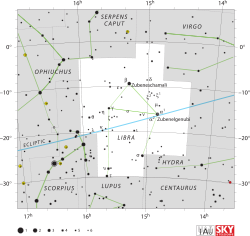Tau Librae
| Tau Librae (τ) | |
 | |
| Observationsdata Epok: J2000.0 | |
|---|---|
| Stjärnbild | Vågen |
| Rektascension | 15t 38m 39,36950s[1] |
| Deklination | -29° 46′ 39,8956″[1] |
| Skenbar magnitud () | 3,68[2] |
| Stjärntyp | |
| Spektraltyp | B2,5 V[3] |
| U–B | -0,717[2] |
| B–V | -0,179[2] |
| Astrometri | |
| Radialhastighet () | +33,3 ± 2,3[4] km/s |
| Egenrörelse (µ) | RA: -22,08[1] mas/år Dek.: -24,46[1] mas/år |
| Parallax () | 8,89 ± 0,20[1] |
| Avstånd | 367 ± 8 lå (112 ± 3 pc) |
| Detaljer | |
| Massa | 7,25 ± 0,49 [5] M☉ |
| Radie | 3,2[6] R☉ |
| Luminositet | 2,705[5] L☉ |
| Temperatur | 17 990[7] K |
| Metallicitet | 0,17[7] dex |
| Vinkelhastighet | 134[4] km/s |
| Ålder | 31,5 ± 5,6[8] miljoner år |
| Andra beteckningar | |
| τ Lib, 40 Librae , CD- 299 11837, HD 139365, HIP 76600, HR 5812, SAO 183649.[9] | |
Tau Librae (τ Librae, förkortat Tau Lib, τ Lib) som är stjärnans Bayerbeteckning, är en dubbelstjärna belägen i den södra delen av stjärnbilden Vågen. Den har en skenbar magnitud på 3,68[2] och är synlig för blotta ögat. Baserat på parallaxmätning inom Hipparcosuppdraget på ca 8,9 mas,[1] beräknas den befinna sig på ett avstånd av ca 367 ljusår (112 parsek) från solen.
Egenskaper
[redigera | redigera wikitext]Tau Librae är en blå stjärna av spektralklass B2,5 V.[3] Den har en massa som är 7,25 gånger större än solens massa och en uppskattad radie som 3,2[6] gånger större än solens. Den utsänder från dess fotosfär 2,7 gånger mera energi än solen vid en effektiv temperatur på ca 18 000 K[7].
Att döma av stjärnans rörelse genom rymden och fysikaliska egenskaper är den medlem i gruppen Upper Scorpius Centaurus Association.[4] Den är en dubbelsidig [10] spektroskopisk dubbelstjärna med en omloppsperiod på endast 3,3 dygn och en excentricitet på 0,28.[11] Primärstjärnan Tau Librae A är endast 31,5 miljoner år gammal och roterar relativt snabbt med en prognostiserad rotationshastighet på 134 km/s.[4] Den avger ett överskott av infraröd strålning, vilket tyder på närvaro av en omkretsande skiva av stoft.[7]
Källor
[redigera | redigera wikitext]- Den här artikeln är helt eller delvis baserad på material från engelskspråkiga Wikipedia, tidigare version.
Referenser
[redigera | redigera wikitext]- ^ [a b c d e f] van Leeuwen, F. (2007), "Validation of the new Hipparcos reduction", Astronomy and Astrophysics, 474 (2): 653–664, Bibcode:2007A&A...474..653V, arXiv:0708.1752 Freely accessible, doi:10.1051/0004-6361:20078357.
- ^ [a b c d] Gutierrez-Moreno, Adelina; Moreno, Hugo (June 1968), "A photometric investigation of the Scorpio-Centaurus association", Astrophysical Journal Supplement, 15: 459, Bibcode:1968ApJS...15..459G, doi:10.1086/190168.
- ^ [a b] Hiltner, W. A.; Garrison, R. F.; Schild, R. E. (July 1969), "MK Spectral Types for Bright Southern OB Stars", Astrophysical Journal, 157: 313–326, Bibcode:1969ApJ...157..313H, doi:10.1086/150069.
- ^ [a b c d] Jilinski, E.; et al. (March 2006), "Radial velocity measurements of B stars in the Scorpius-Centaurus association", Astronomy and Astrophysics, 448 (3): 1001–1006, Bibcode:2006A&A...448.1001J, arXiv:astro-ph/0601643 Freely accessible, doi:10.1051/0004-6361:20041614.
- ^ [a b] Hohle, M. M.; et al. (April 2010), "Masses and luminosities of O- and B-type stars and red supergiants", Astronomische Nachrichten, 331 (4): 349, Bibcode:2010AN....331..349H, arXiv:1003.2335 Freely accessible, doi:10.1002/asna.200911355.
- ^ [a b] Pasinetti-Fracassini, L. E.; et al. (February 2001), "Catalog of Apparent Diameters and Absolute Radii of Stars (CADARS)", Astronomy and Astrophysics (3rd ed.), 367: 521−524, Bibcode:2001A&A...367..521P, arXiv:astro-ph/0012289 Freely accessible, doi:10.1051/0004-6361:20000451.
- ^ [a b c d] Saffe, C.; Gómez, M.; Pintado, O.; González, E. (October 2008), "Spectroscopic metallicities of Vega-like stars", Astronomy and Astrophysics, 490 (1): 297−305, Bibcode:2008A&A...490..297S, arXiv:0805.3936 Freely accessible, doi:10.1051/0004-6361:200810260.
- ^ Tetzlaff, N.; Neuhäuser, R.; Hohle, M. M. (January 2011), "A catalogue of young runaway Hipparcos stars within 3 kpc from the Sun", Monthly Notices of the Royal Astronomical Society, 410 (1): 190–200, Bibcode:2011MNRAS.410..190T, arXiv:1007.4883 Freely accessible, doi:10.1111/j.1365-2966.2010.17434.x.
- ^ "tau Lib -- Spectroscopic binary", SIMBAD Astronomical Database, Centre de Données astronomiques de Strasbourg, hämtad 2017-01-30.
- ^ Strom, Stephen E.; et al. (February 2005), "B Star Rotational Velocities in h and χ Persei: A Probe of Initial Conditions during the Star Formation Epoch?", The Astronomical Journal, 129 (2): 809−828, Bibcode:2005AJ....129..809S, arXiv:astro-ph/0410337 Freely accessible, doi:10.1086/426748.
- ^ Pourbaix, D.; et al. (2004), "SB9: The ninth catalogue of spectroscopic binary orbits", Astronomy and Astrophysics, 424 (2): 727–732, Bibcode:2004A&A...424..727P, arXiv:astro-ph/0406573 Freely accessible, doi:10.1051/0004-6361:20041213.




